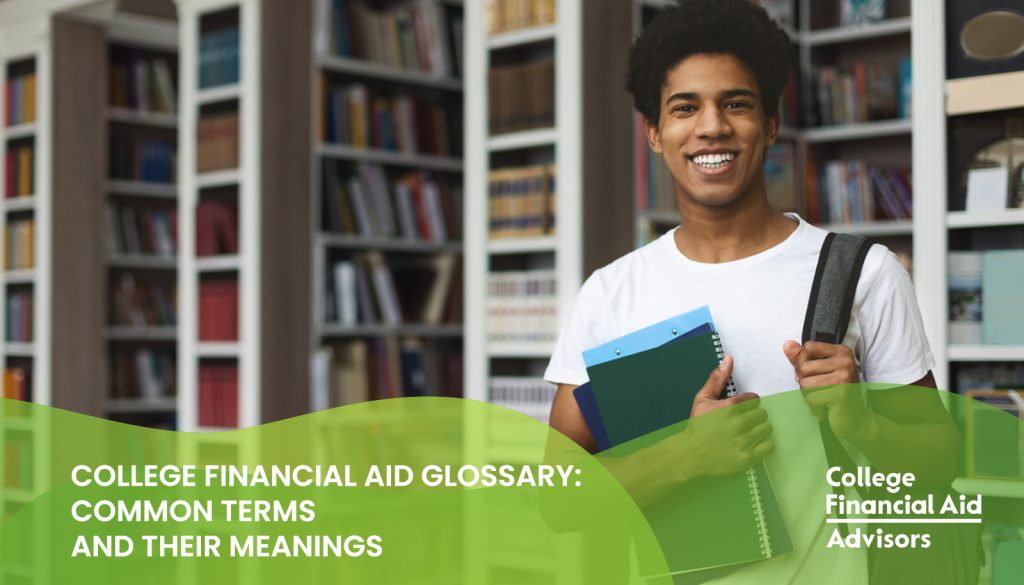College Financial Aid Glossary: Common Terms and Their Meanings that Students and Parents Should Know
Navigating the financial aid process as a college student or first time college parent can feel mind-boggling, especially with the numerous terms and acronyms thrown around. Almost every financial aid application or letter will have at least one of these acronyms so it’s important to start recognizing them. I want you to feel confident and comfortable as you navigate all of the documents you’ll be handling over the next year! To help you understand the financial aid landscape and make informed decisions as a college-bound student (or with them as a parent), I’ve put together a glossary of the most common financial aid terms and their meanings. FAFSA (Free Application for Federal Student Aid) The FAFSA is a form that students and their families fill out to determine their eligibility for financial aid, including federal grants, work-study programs, and loans. It is essential to fill out the FAFSA as early as possible to maximize your financial aid options! This typically opens in October. Student Aid Index The Student Aid Index is replacing the Expected Family Contribution from prior years, which was the amount a family would have to pay out-of-pocket for college expenses. Now, the SAI will help colleges and universities determine how much funding a student can receive. You can read about how the SAI might impact your family here! Grants Grants are a type of financial aid that are not repaid. They are based on financial need. The most common federal grant is the Pell Grant, which is available to undergraduate students who demonstrate significant financial need. The new SAI is making the Pell Grant more available to many students! Scholarships Scholarships are funds awarded to students based on various criteria, including academic achievement, extracurricular involvement, or specific talents. Like grants, scholarships do not get repaid. Scholarships come from colleges, private organizations, or community groups. Check for these frequently – even after college acceptance – to help keep your costs low! Loans Loans are borrowed funds that must be repaid with interest. There are several types of student loans, including federal loans (such as Direct Subsidized and Unsubsidized Loans) and private loans from banks or other financial institutions. Federal loans generally offer more favorable terms and repayment options than private loans. Read about the differences here! Work-Study Programs Work-study is a federal program that provides part-time jobs for students with financial need. The program allows them to earn money to help pay for their education expenses. These jobs are typically on-campus, but some may be with local nonprofits or community organizations. COA (Cost of Attendance) The COA is the total estimated cost of attending a particular college or university for one academic year. It includes tuition and fees, room and board, books and supplies, transportation, and personal expenses. The COA is necessary to help determine a student’s financial need and aid eligibility. FAFSA Submission Summary The FAFSA Submission Summary is a summary of the information provided when you complete the FAFSA. Simple as that! It also indicates a student’s eligibility for federal student aid. Colleges use the this summary to prepare financial aid packages for students. Award Letters Award letters are documents from a college or university to a student that list the types and amounts of financial aid they are eligible to receive. This may include grants, scholarships, loans, and work-study opportunities. It is important to carefully review and compare award letters from different schools to understand the full cost of attendance and the amount of aid provided. When you compare letters, remember to pay special attention to what the numbers say! Understanding these key financial aid terms can empower you to make informed decisions and effectively plan for your college expenses. Familiarize yourself with this glossary to ensure you’re able to navigate the financial aid process with confidence. Remember, every dollar saved or earned through financial aid can make a significant difference in making college more affordable for you and your family. Good luck! More about Jodi and College Financial Aid Advisors Jodi is a FAFSA financial advisor who helps with the financial aid process to help families of college students maximize their financial aid. From completing the FAFSA and completing the CSS Profile to reviewing the SAR, responding to requests for verification, comparing financial aid offers and understanding student loan options, Jodi is a fantastic resource when it comes to student financial aid. Schedule a 15 Minute Power Chat to learn more about finding ways to pay for college.










